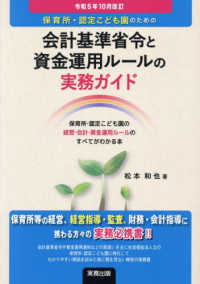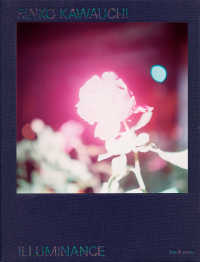Full Description
This book examines the use of precious cloths in courtly settings East and West between the fourth and the sixteenth centuries. The fresh evidence, drawn from surviving precious cloths together with new interpretations of contemporary written and visual sources, allow for an exploration of common mentalities evident behind the use of precious cloths over the period of more than a millennium and across a vast geographical expanse.
The seeds for the writing of this book were sown in 2017, at an international textile conference, 'Precious Cloth and Court Culture', held at Lucy Cavendish College, University of Cambridge. The aim of the conference was to draw together textile specialists from across the world to examine how far contacts between courts from Europe to China were mediated through the use and exchange of precious cloth. For the first time, precious court cloths were examined as agents of cultural identity, and as global medium and catalyst for political and socio-economic development and change.
The book encompasses the findings of the conference whilst greatly extending its original scope through the addition of new material and also through the reworking, amplification, and inter-linking of common themes across the original papers. In line with current interest in the mapping of 'global histories' the book draws on the textile evidence from right across the medieval and early modern world. Over the period of an entire millennium, this enables a series of parallels to be drawn between the use of precious cloths across Latin, Byzantine/Islamic Mediterranean, Near Eastern, Central Asian and Far Eastern courts.
The eleven chapters which make up the book are divided into two sections. The first section consists of seven chapters and geographically covers Latin Europe and the Byzantine and Islamic Mediterranean, whilst section two with four further chapters, moves the discussion across from Eurasia to the Far East. It is the first publication to draw together evidence from both East and West in order to assess the nature of and the very considerable impact of the use of precious cloth across courts of the mediaeval and early modern world.
Contents
Preface; Part One. Latin Europe and the Byzantine/Islamic Mediterranean: The Lion-Hunt Silk Damask of St Ambrose's Dalmatic. Court Context, Reconstruction and Relation to Late Antique Figured Silk Weaving Technology, by Hero Granger-Taylor; Byzantine, Islamic and Near Eastern Silks, Expressions of Courtly Piety and Power at the Merovingian, Carolingian, Ottonian and Later Latin Courts, by Anna Muthesius; Precious Textiles and Courtly Culture in Medieval Castile (ca. 1155-ca.1284), by María Barrigón Montañés; 'Mix And Match': The Furnishing of English Royal Palaces in the Later Middle Ages (1300-1470), by Lisa Monnas; 'Thre Cusshions of Clothe of Gold Tissued': The Role of Luxury Textiles at the Court of Henry VIII, by Maria Hayward; Early Modern Fashionable Bobbin-Made Lace or Passement of Gold and Silver Thread, by Lena Dahren; 'Silk as Power' at the Byzantine Court and Intra-Cultural Connectivity across the Silk Road (4-15 Century), by Anna Muthesius; Part Two. Eurasia and the Far East: Precious Cloths in the Singhas?ri Court of King Krtan?gara 1258-1292, by Lesley Pullen; Early Chinese Rank Badges. A Collector's Note, by Chris Hall; From Heaven to Earth: Transformation of Motifs on Ming Court Robes (14th-16th Century), by Sally Yu Leung; Ottoman Turkish Ceremonial Court Attire and Furnishings: Symbols of Power and Dynastic Heritage, by Sibel Alpaslan Arça; Index; Colour Plates.







